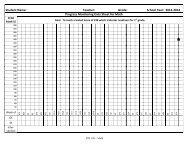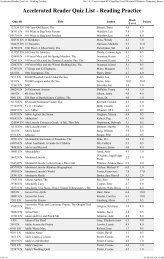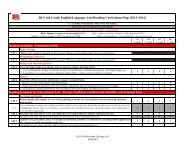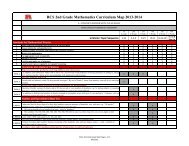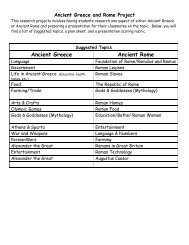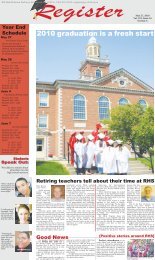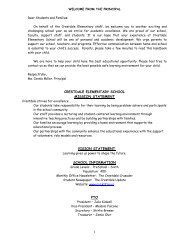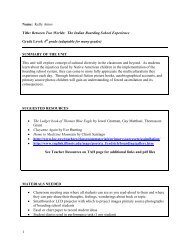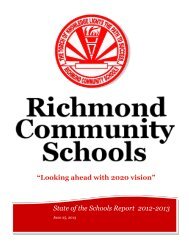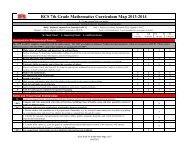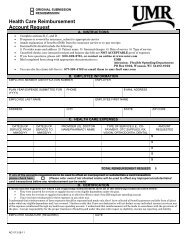RCS 4th Grade English/Language Arts/Reading Curriculum Map ...
RCS 4th Grade English/Language Arts/Reading Curriculum Map ...
RCS 4th Grade English/Language Arts/Reading Curriculum Map ...
You also want an ePaper? Increase the reach of your titles
YUMPU automatically turns print PDFs into web optimized ePapers that Google loves.
4.RF.1<br />
4.RF.2<br />
4.RF.3<br />
4.RF.4<br />
Bold: Indiana Common Core Standard (INCC)<br />
Regular: IAS not aligned to INCC but tested on ISTEP+<br />
<strong>Reading</strong> Standards: Foundational Skills<br />
Print Concepts<br />
<strong>RCS</strong> <strong>4th</strong> <strong>Grade</strong> <strong>English</strong>/<strong>Language</strong> <strong>Arts</strong>/<strong>Reading</strong> <strong>Curriculum</strong> <strong>Map</strong> (2013-2014)<br />
X = COVERED IN READING STREET THIS SIX WEEKS<br />
TESTED ON ACUITY DIAGNOSTIC ASSESSMENT<br />
(There is not a grade 4 standard for this concept. Please see preceding grades for more information).<br />
Phonological Awareness<br />
(There is not a grade 4 standard for this concept. Please see preceding grades for more information).<br />
Phonics and Word Recognition<br />
Italics: Indiana Academic Standard (IAS) aligned to INCC<br />
(Italics in Parentheses): Local standard or accessed on Acuity<br />
Know and apply grade-level phonics and word analysis skills in decoding words.<br />
a. Use combined knowledge of all letter-sound correspondences, syllabication patterns, and morphology (e.g.,<br />
roots and affixes) to read accurately unfamiliar multisyllabic words in context and out of context.<br />
Fluency<br />
1st<br />
9 weeks<br />
2nd<br />
9 weeks<br />
3rd<br />
9 weeks<br />
<strong>4th</strong><br />
9 weeks<br />
X X X X<br />
Read with sufficient accuracy and fluency to support comprehension.<br />
a. Read on-level text with purpose and understanding. X X X X<br />
b. Read on-level prose and poetry orally with accuracy, appropriate rate, and expression on successive readings. X X X X<br />
c. Use context to confirm or self-correct word recognition and understanding, rereading as necessary. X X X X<br />
<strong>Reading</strong> Standards for Informational Text: Literary Nonfiction and Historical, Scientific, and Technical Texts<br />
Key Ideas and Details<br />
Number in Red : May be tested on ISTEP+ Applied Skills<br />
4.RI.1<br />
Refer to details and examples in a text when explaining what the text says explicitly and when drawing inferences<br />
from the text.<br />
X X X X<br />
4.2.3<br />
Draw conclusions or make and confirm predictions about text by using prior knowledge and ideas presented in the text itself,<br />
including illustrations, titles, topic sentences, important words, foreshadowing clues (clues that indicate what might happen X X X X<br />
next), and direct quotations.<br />
4.RI.2 Determine the main idea of a text and explain how it is supported by key details; summarize the text. X X X X<br />
4.2.9 Recognize main ideas and supporting details presented in expository (informational texts). X X X X<br />
4.RI.3<br />
Explain events, procedures, ideas, or concepts in a historical, scientific, or technical text, including what happened and<br />
why, based on specific information in the text.<br />
X X X X<br />
4.2.6 Distinguish between cause and effect and between fact and opinion in informational text.<br />
2013-2014 <strong>4th</strong> <strong>Grade</strong> ELA Page 1 of 7<br />
7/22/2013
(4.2.7) (Follow multiple-step instructions in a basic technical manual.)<br />
(4.2.8)<br />
(Identify informational texts written in narrative form (sometimes with undeveloped characters and minimal dialogue) using<br />
sequence or chronology.)<br />
4.RI.4<br />
Determine the meaning of general academic and domain-specific words or phrases in a text relevant to a grade 4 topic<br />
or subject area.<br />
X X X X<br />
4.1.7 Use context to determine the meaning of unknown words. X X X X<br />
4.RI.5<br />
Describe the overall structure (e.g., chronology, comparison, cause/effect, problem/solution) of events, ideas, concepts,<br />
or information in a text or part of a text.<br />
X X X X<br />
4.2.1 Use the organization of informational text to strengthen comprehension. X X X<br />
4.RI.6<br />
Compare and contrast a firsthand and secondhand account of the same event or topic; describe the differences in<br />
focus and the information provided.<br />
X<br />
X<br />
Integration of Knowledge and Ideas<br />
4.RI.7<br />
Interpret information presented visually, orally, or quantitatively (e.g., in charts, graphs, diagrams, time lines,<br />
animations, or interactive elements on Web pages) and explain how the information contributes to an understanding X X X X<br />
of the text in which it appears.<br />
4.RI.8 Explain how an author uses reasons and evidence to support particular points in a text. X X X X<br />
4.RI.9 Integrate information from two texts on the same topic in order to write or speak about the subject knowledgeably. X X X X<br />
4.2.5 Compare and contrast information on the same topic after reading several passages or articles.<br />
4.RI.10<br />
Craft and Structure<br />
Range of <strong>Reading</strong> and Level of Text Complexity<br />
By the end of year, read and comprehend informational texts, including history/social studies, science, and technical<br />
texts, in the grades 4-5 text complexity band proficiently, with scaffolding as needed at the high end of the range.<br />
<strong>Reading</strong> Standards for Literature: Stories, Novels, Dramas, and Poetry<br />
Key Ideas and Details<br />
X X X X<br />
4.RL.1<br />
Refer to details and examples in a text when explaining what the text says explicitly and when drawing inferences<br />
from the text.<br />
X X X X<br />
4.RL.2 Determine a theme of a story, drama, or poem from details in the text; summarize the text. X X X X<br />
4.3.6 Determine the theme. X X<br />
4.RL.3<br />
Describe in depth a character, setting, or event in a story or drama, drawing on specific details in the text (e.g., a<br />
character's thoughts, words, or actions).<br />
X X X X<br />
4.3.3<br />
Use knowledge of the situation, setting, and a character’s traits, motivations, and feelings to determine the causes for that<br />
character’s actions.<br />
X X X<br />
4.3.2<br />
Identify the main events of the plot, including their causes and the effects of each event on future actions, and the major theme<br />
from the story action.<br />
X<br />
4.3.5 Define figurative language, such as similes, metaphors, hyperbole, or personification, and identify its use in literary works.<br />
X<br />
2013-2014 <strong>4th</strong> <strong>Grade</strong> ELA Page 2 of 7<br />
7/22/2013
4.RL.4<br />
Determine the meaning of words and phrases as they are used in a text, including those that allude to significant<br />
characters found in mythology (e.g., Herculean).<br />
Explain major differences between poems, drama, and prose, and refer to the structural elements of poems (e.g., verse,<br />
4.RL.5 rhythm, meter) and drama (e.g., casts of characters, settings, descriptions, dialogue, stage directions) when writing or<br />
speaking about a text.<br />
4.RL.6<br />
Compare and contrast the point of view from which different stories are narrated, including the difference between<br />
first- and third-person narrations.<br />
4.3.7 Identify the narrator in a selection and tell whether the narrator or speaker is involved in the story.<br />
4.RL.7<br />
4.RL.8<br />
4.RL.9<br />
4.3.4<br />
Craft and Structure<br />
Integration of Knowledge and Ideas<br />
Make connections between the text of a story or drama and a visual or oral presentation of the text, identifying where<br />
each version reflects specific descriptions and directions in the text.<br />
(This College and Career Readiness Standard does not have a literature component).<br />
Compare and contrast the treatment of similar themes and topics (e.g., opposition of good and evil) and patterns of<br />
events (e.g., the quest) in stories, myths, and traditional literature from different cultures.<br />
Compare and contrast tales from different cultures by tracing the adventures of one character type. Tell why there are similar<br />
tales in different cultures.<br />
Range of <strong>Reading</strong> and Level of Text Complexity<br />
X X X X<br />
X X X X<br />
X X X X<br />
X X X<br />
X X X<br />
4.RL.10<br />
By the end of the year, read and comprehend literature, including stories, dramas, and poetry, in the grades 4-5 text<br />
complexity band proficiently, with scaffolding as needed at the high end of the range.<br />
X X X X<br />
Writing Standards<br />
Text Types and Purposes<br />
4.W.1 Write opinion pieces on topics or texts, supporting a point of view with reasons and information.<br />
a. Introduce a topic or text clearly, state an opinion, and create an organizational structure in which related ideas are<br />
grouped to support the writer's purpose.<br />
X X X<br />
b. Provide reasons that are supported by facts and details. X X X X<br />
c. Link opinion and reasons using words and phrases (e.g., for instance, in order to, in addition). X X X<br />
d. Provide a concluding statement or section related to the opinion presented. X X X<br />
4.W.2 Write informative/explanatory texts to examine a topic and convey ideas and information clearly. (IAS 4.4.2. 4.4.3, and 4.4.4)<br />
a. Introduce a topic clearly and group related information in paragraphs and sections; include formatting (e.g., headings),<br />
illustrations, and multimedia when useful to aiding comprehension.<br />
X X X X<br />
b. Develop the topic with facts, definitions, concrete details, quotations, or other information and examples related to the topic. X X X X<br />
c. Link ideas within categories of information using words and phrases (e.g., another, for example, also, because). X X X<br />
d. Use precise language and domain-specific vocabulary to inform about or explain the topic. X X X<br />
e. Provide a concluding statement or section related to the information or explanation presented. X X<br />
X<br />
2013-2014 <strong>4th</strong> <strong>Grade</strong> ELA Page 3 of 7<br />
7/22/2013
4.W.3 Write narratives to develop real or imagined experiences or events using effective technique, descriptive details and clear event sequences.<br />
a. Orient the reader by establishing a situation and introducing a narrator and/or characters; organize an event sequence that<br />
unfolds naturally<br />
X X X X<br />
b. Use dialogue and description to develop experiences and events or show the responses of characters to situations. X X X<br />
c. Use a variety of transitional words and phrases to manage the sequence of events. X X X<br />
d. Use concrete words and phrases and sensory details to convey experiences and events precisely. X X X<br />
e. Provide a conclusion that follows from the narrated experiences or events. X X X<br />
4.5.1 Write narratives that: X X X X<br />
· include ideas, observations, or memories of an event or experience.<br />
· provide a context to allow the reader to imagine the world of the event or experience.<br />
· use concrete sensory details.<br />
4.5.5 Use varied word choices to make writing interesting.<br />
4.W.4<br />
Production and Distribution of Writing<br />
Produce clear and coherent writing in which the development and organization are appropriate to task, purpose, and<br />
audience. (IAS 4.6.3 Create interesting sentences by using words that describe, explain, or provide additional details and X X X X<br />
connections, such as verbs, adjectives, adverbs, appositives, participial phrases, prepositional phrases, and conjunctions.)<br />
4.W.5<br />
With guidance and support from peers and adults, develop and strengthen writing as needed by planning, revising,<br />
and editing.<br />
X X X<br />
4.4.10 Review, evaluate, and revise writing for meaning and clarity.<br />
4.4.12 Revise writing by combining and moving sentences and paragraphs to improve the focus and progression of ideas.<br />
4.W.6<br />
With some guidance and support from adults, use technology, including the Internet, to produce and publish writing<br />
as well as to interact and collaborate with others; demonstrate sufficient command of keyboarding skills to type a X X X<br />
minimum of one page in a single sitting. (IAS 4.4.9)<br />
(4.6.1) (Write smoothly and legibly in cursive, forming letters and words that can be read by others.)<br />
4.W.7<br />
Research to Build and Present Knowledge<br />
Conduct short research projects that build knowledge through investigation of different aspects of a topic. X X X X<br />
4.W.8<br />
Recall relevant information from experiences or gather relevant information from print and digital sources; take notes<br />
and categorize information, and provide a list of sources.<br />
X X X X<br />
4.W.9 Draw evidence from literary or informational texts to support analysis, reflection, and research.<br />
a. Apply grade 4 <strong>Reading</strong> standards to literature (e.g., "Describe in depth a character, setting, or event in a story or drama,<br />
drawing on specific details in the text [e.g., a character's thoughts, words, or actions].").<br />
X X X X<br />
b. Apply grade 4 <strong>Reading</strong> standards to informational texts (e.g., "Explain how an author uses reasons and evidence to support<br />
particular points in a text.").<br />
X X X X<br />
2013-2014 <strong>4th</strong> <strong>Grade</strong> ELA Page 4 of 7<br />
7/22/2013
4.4.6 Locate information in reference texts by using organizational features, such as prefaces and appendixes.<br />
4.4.8 Understand the organization of almanacs, newspapers, and periodicals and how to use those print materials.<br />
4.W.10<br />
Range of Writing<br />
Write routinely over extended time frames (time for research, reflection, and revision) and shorter time frames (a<br />
single sitting or a day or two) for a range of discipline-specific tasks, purposes, and audiences.<br />
X X<br />
4.5.6 Write for different purposes (information, persuasion, description) and to a specific audience or person.<br />
<strong>Language</strong> Standards<br />
Conventions of Standard <strong>English</strong><br />
4.L.1 Demonstrate command of the conventions of Standard <strong>English</strong> grammar and usage when writing or speaking.<br />
a. Use relative pronouns (who, whose, whom, which, that) and relative adverbs (where, when, why). X X X<br />
b. Form and use the progressive (e.g., I was walking; I am walking; I will be walking) verb tenses.<br />
c. Use modal auxiliaries (e.g., can, may, must) to convey various conditions.<br />
d. Order adjectives within sentences according to conventional patterns (e.g., a small red bag rather than a red small bag). X<br />
e. Form and use prepositional phrases. X<br />
f. Produce complete sentences, recognizing and correcting inappropriate fragments and run-ons. X X<br />
g. Correctly use frequently confused words (e.g., to, too, two; there, their). X<br />
4.6.2<br />
Use simple sentences (Dr. Vincent Stone is my dentist.) and compound sentences (His assistant cleans my teeth, and Dr. Stone<br />
checks for cavities.) in writing.<br />
X X X X<br />
4.6.4<br />
Identify and use in writing regular ( live/lived, shout/shouted) and irregular verbs (swim/swam, ride/rode, hit/hit),<br />
adverbs (constantly, quickly), and prepositions (through, beyond, between).<br />
X X X<br />
4.L.2 Demonstrate command of the conventions of Standard <strong>English</strong> capitalization, punctuation, and spelling when writing.<br />
a. Use correct capitalization. X X<br />
b. Use commas and quotation marks to mark direct speech and quotations from a text. X X<br />
c. Use a comma before a coordinating conjunction in a compound sentence. X<br />
d. Spell grade-appropriate words correctly, consulting references as needed. X X X<br />
e. Consult reference materials, including beginning dictionaries, as needed to check and correct spellings. X<br />
4.6.5<br />
Use parentheses to explain something that is not considered of primary importance to the sentence, commas in direct<br />
quotations ( He said, “I’d be happy to go.”), apostrophes to show possession (Jim’s shoes, the dog’s food), and<br />
X<br />
apostrophes in contractions (can’t, didn’t, won’t).<br />
4.6.7<br />
Capitalize names of magazines, newspapers, works of art, musical compositions, organizations, and the first word in<br />
quotations, when appropriate.<br />
X<br />
X<br />
4.6.8<br />
Spell correctly roots (bases of words, such as un necessary , coward ly), inflections (words like care/care ful /car ing ),<br />
words with more than one acceptable spelling (like advisor/adviser), suffixes and prefixes (-ly, -ness, mis-, un-),<br />
and syllables (word parts each containing a vowel sound, such as sur•prise or e•col•o•gy).<br />
2013-2014 <strong>4th</strong> <strong>Grade</strong> ELA Page 5 of 7<br />
7/22/2013
Knowledge of <strong>Language</strong><br />
4.L.3 Use knowledge of language and its conventions when writing, speaking, reading, or listening.<br />
a. Use correct capitalization. X X X<br />
b. Use commas and quotation marks to mark direct speech and quotations from a text. X X<br />
c. Use a comma before a coordinating conjunction in a compound sentence. X X X<br />
d. Spell grade-appropriate words correctly, consulting references as needed. X X<br />
Vocabulary Acquisition and Use<br />
4.L.4<br />
Determine or clarify the meaning of unknown and multiple-meaning word and phrases based on grade 4 reading and content, choosing flexibly from a range of<br />
strategies.<br />
a. Use context (e.g., definitions, examples, or restatements in text) as a clue to the meaning of a word or phrase. X X X<br />
b. Use common, grade-appropriate Greek and Latin affixes and roots as clues to the meaning of a word (e.g., telegraph,<br />
photograph, autograph).<br />
X X X<br />
c. Consult reference materials (e.g., dictionaries, glossaries, thesauruses), both print and digital, to find the pronunciation and<br />
determine or clarify the precise meaning of key words and phrases.<br />
X X X<br />
d. Use glossaries or beginning dictionaries, both print and digital, to determine or clarify the precise meaning of key words<br />
and phrases.<br />
4.1.3<br />
Use knowledge of root words ( nation, national, nationality) to determine the meaning of unknown words within a<br />
passage.<br />
X<br />
4.1.4<br />
Use common roots ( meter = measure) and word parts (therm = heat) derived from Greek and Latin to analyze the<br />
meaning of complex words (thermometer).<br />
X X X X<br />
4.1.5 Use a thesaurus to find related words and ideas. X X X<br />
4.1.6<br />
Distinguish and interpret words with multiple meanings ( quarters) by using context clues (the meaning of the text<br />
around a word).<br />
X<br />
X<br />
4.1.7 Use context to determine the meaning of unknown words. X X X X<br />
4.L.5 Demonstrate understanding of figurative language, word relationships, and nuances in word meanings.<br />
a. Explain the meaning of simple similes and metaphors (e.g., as pretty as a picture) in context. X X<br />
b. Recognize and explain the meaning of common idioms, adages, and proverbs. X X X<br />
c. Demonstrate understanding of words by relating them to their opposites (antonyms) and to words with similar but not<br />
identical meanings (synonyms).<br />
X X X<br />
4.1.2<br />
Apply knowledge of synonyms (words with the same meaning), antonyms (words with opposite meanings), homographs<br />
(words that are spelled the same but have different meanings), and idioms (expressions that cannot be understood just by<br />
knowing the meanings of the words in the expression, such as couch potato) to determine the meaning of words and<br />
X X X X<br />
phrases.<br />
4.3.5 Define figurative language, such as similes, metaphors, hyperbole, or personification, and identify its use in literary works.<br />
4.L.6<br />
Acquire and use accurately grade-appropriate general academic and domain-specific words and phrases, including<br />
those that signal precise actions, emotions, or states of being (e.g., quizzed, whined, stammered) and that are basic to a<br />
particular topic (e.g., wildlife, conservation, and endangered when discussing animal preservation).<br />
X X X X<br />
2013-2014 <strong>4th</strong> <strong>Grade</strong> ELA Page 6 of 7<br />
7/22/2013
Speaking and Listening Standards<br />
Comprehension and Collaboration<br />
4.SL.1<br />
Engage effectively in a range of collaborative discussions (one-on-one, in groups, and teacher-led) with diverse partners on grade 4 topics and texts, building on<br />
others' ideas and expressing their own clearly.<br />
a. Come to discussions prepared, having read or studied required material; explicitly draw on that preparation and other<br />
information known about the topic to explore ideas under discussion.<br />
X X X<br />
b. Follow agreed-upon rules for discussions (e.g., gaining the floor in respectful ways, listening to others with care, speaking<br />
one at a time about the topics and texts under discussion).<br />
X X X<br />
c. Pose and respond to specific questions to clarify or follow up on information, and make comments that contribute to the<br />
discussion and link to the remarks of others.<br />
X X X<br />
d. Review the key ideas expressed and explain their own ideas and understanding in light of the discussion. X X X<br />
4.SL.2<br />
Paraphrase portions of a text read aloud or information presented in diverse media and formats, including visually,<br />
quantitatively, and orally.<br />
X<br />
4.SL.3 Identify the reasons and evidence a speaker provides to support particular points. X X X X<br />
Presentation of Knowledge and Ideas<br />
4.SL.4<br />
Report on a topic or text, tell a story, or recount an experience in an organized manner, using appropriate facts and<br />
relevant, descriptive details to support main ideas or themes; speak clearly at an understandable pace.<br />
X X X<br />
4.SL.5<br />
Add audio recordings and visual displays to presentations when appropriate to enhance the development of main ideas<br />
or themes.<br />
X<br />
4.SL.6<br />
Differentiate between contexts that call for formal <strong>English</strong> (e.g., presenting ideas) and situations where informal<br />
discourse is appropriate (e.g., small-group discussion); use formal <strong>English</strong> when appropriate to task and situation.<br />
2013-2014 <strong>4th</strong> <strong>Grade</strong> ELA Page 7 of 7<br />
7/22/2013



